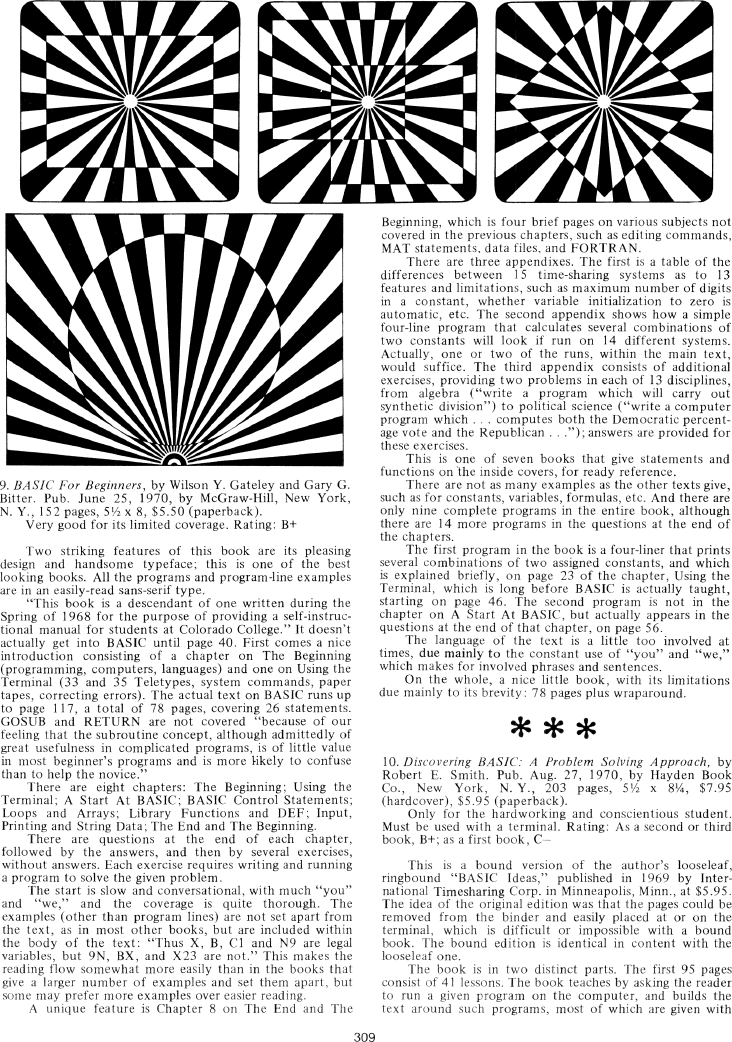The Best of Creative Computing Volume 1 (published 1976)
Reviews of 34 Books on BASIC (BASIC for Beginners, by Wilson Y. Gateley and Gary G. Bitter, 1970)

9. BASIC For Beginners, by Wilson Y. Gateley and Gary G.
Bitter. Pub. June 25, 1970, by McGraw-Hill, New York,
N. Y., 152 pages, 5 1/2 x 8, $5.50 (paperback).
Very good for its limited coverage. Rating: B+
Two striking features of this book are its pleasing
design and handsome typeface; this is one of the best
looking books. All the programs and program-line examples
are in an easily-read sans-serif type.
"This book is a descendant of one written during the
Spring of 1968 for the purpose of providing a self-instructional
manual for students at Colorado College." It doesn't
actually get into BASIC until page 40. First comes a nice
introduction consisting of a chapter on The Beginning
(programming, computers, languages) and one on Using the
Terminal (33 and 35 Teletypes, system commands, paper
tapes, correcting errors). The actual text on BASIC runs up
to page 117, a total of 78 pages, covering 26 statements.
GOSUB and RETURN are not covered "because of our
feeling that the subroutine concept, although admittedly of
great usefulness in complicated programs, is of little value
in most beginner's programs and is more likely to confuse
than to help the novice."
There are eight chapters: The Beginning; Using the
Terminal; A Start At BASIC; BASIC Control Statements;
Loops and Arrays; Library Functions and DEF; Input,
Printing and String Data; The End and The Beginning,
There are questions at the end of each chapter,
followed by the answers, and then by several exercises,
without answers. Each exercise requires writing and running
a program to solve the given problem.
The start is slow and conversational, with much "you"
and "we," and the coverage is quite thorough. The
examples (other than program lines) are not set apart from
the text, as in most other books, but are included within
the body of the text: "Thus X, B, C1 and N9 are legal
variables, but 9N, BX, and X23 are not." This makes the
reading flow somewhat more easily than in the books that
give a larger number of examples and set them apart. but
some may prefer more examples over easier reading.
A unique feature is Chapter 8 on The End and The
Beginning, which is four brief pages on various subjects not
covered in the previous chapters, such as editing commands,
MAT statements. data files. and FORTRAN.
There are three appendixes. The first is a table of the
differences between 15 time-sharing systems as to 13
features and limitations, such as maximum number of digits
in a constant, whether variable initialization to zero is
automatic, etc. The second appendix shows how a simple
four-line program that calculates several combinations of
two constants will look if run on 14 different systems.
Actually, one or two of the runs, within the main text,
would suffice. The third appendix consists of additional
exercises, providing two problems in each of 13 disciplines,
from algebra ("write a program which will carry out
synthetic division") to political science ("write a computer
program which ... computes both the Democratic percentage
vote and the Republican ..."); answers are provided for
these exercises.
This is one of seven books that give statements and
functions onthe inside covers, for ready reference.
There are not as many examples as the other texts give,
such as for constants, variables, formulas, etc. And there are
only nine complete programs in the entire book, although
there are 14 more programs in the questions at the end of
the chapters.
The first program in the book is a four-liner that prints
several combinations of two assigned constants, and which
is explained briefly, on page 23 of the chapter, Using the
Terminal, which is long before BASIC is actually taught,
starting on page 46. The second program is not in the
chapter on A Start At BASIC, but actually appears in the
questions at the end of that chapter, on page 56.
The language of the text is a little too involved at
times, due mainly to the constant use of "you" and "we,"
which makes for involved phrases and sentences.
On the whole, a nice little book, with its limitations
due mainly to its brevity: 78 pages plus wraparound.
[image]
10, Discovering BASIC; A Problem Solving Approach, by
Robert E. Smith. Pub. Aug. 27, 1970, by Hayden Book
Co., New York, N. Y., 203 pages, 5 1/2 X 8 1/2, $7,95
(hardcover), $5.95 (paperback).
Only for the hardworking and conscientious student.
Must be used with a terminal. Rating: As a second or third
book, B+; as a first book, C
This is a bound version of the autlior's looseleaf,
ringbound "BASIC Ideas," published in 1969 by International
Timesharing Corp. in Minneapolis, Minn., at $5.95.
The idea of the original edition was that the pages could be
removed from the binder and easily placed at or on the
terminal. which is difficult or impossible with a bound
book. The bound edition is identical in content with the
looseleaf one.
The book is in two distinct parts. The first 95 pages
consist of 41 lessons. The book teaches by asking the reader
to run a given program on the computer, and builds the
text around such programs, most of which are given with


